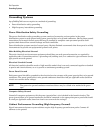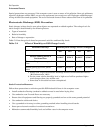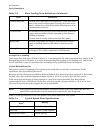
Appendix C
Site Preparation
Environmental Elements
113
CAUTION Low humidity contributes to undesirably high levels of electrostatic charges. This increases the
electrostatic discharge (ESD) voltage potential. ESD can cause component damage during
servicing operations. Paper feed problems on high-speed printers are usually encountered in
low-humidity environments.
Low humidity levels are often the result of the facility heating system and occur during the cold season. Most
heating systems cause air to have a low humidity level, unless the system has a built-in humidifier.
Air Conditioning Ducts
Use separate computer room air conditioning duct work. If it is not separate from the rest of the building, it
might be difficult to control cooling and air pressure levels. Duct work seals are important for maintaining a
balanced air conditioning system and high static air pressure. Adequate cooling capacity means little if the
direction and rate of air flow cannot be controlled because of poor duct sealing. Also, the ducts should not be
exposed to warm air, or humidity levels may increase.
Dust and Pollution Control
Computer equipment can be adversely affected by dust and microscopic particles in the site environment.
Specifically, disk drives, tape drives, and some other mechanical devices can have bearing failures resulting
from airborne abrasive particles. Dust may also blanket electronic components like printed circuit boards
causing premature failure due to excess heat and/or humidity build up on the boards. Other failures to power
supplies and other electronic components can be caused by metallically conductive particles. These metallic
particles are conductive and can short circuit electronic components. Use every effort to ensure that the
environment is as dust and particulant free as possible.
Smaller particles can pass though some filters and, over a period of time, resulting in possible cause problems
in mechanical parts. Small dust particles can be prevented from entering the computer room by maintaining
its air conditioning system at a high static air pressure level.
Other sources of dust, metallic, conductive, abrasive, and/or microscopic particles can be present. Some
sources of these particulants are:
• Subfloor shedding
• Raised floor shedding
• Ceiling tile shedding
These pollutants are not always visible to the naked eye. A good check to determine their possible presence is
to check the underside of the tiles. The tile should be shiny, galvanized, and free from rust.
The computer room should be kept clean. The following guidelines are recommended:
• Smoking—Establish a no-smoking policy. Cigarette smoke particles are eight times larger than the
clearance between disk drive read/write heads and the disk surface.
• Printer—Locate printers and paper products in a separate room to eliminate paper particulate problems.
• Eating or drinking—Establish a no-eating or drinking policy. Spilled liquids can cause short circuits in
equipment such as keyboards.
• Tile floors—Use a dust-absorbent cloth mop rather than a dry mop to clean tile floors.


















